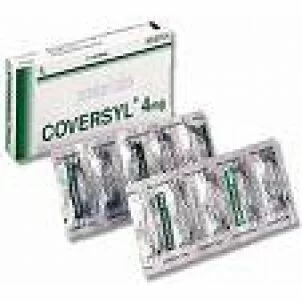Coversyl 4 mg. 14 tabs
 Click image to enlarge |
|
Description
Coversyl - Coversyl Side Effects - Coversyl Information Pharmacology: Perindopril is a nonsulphydryl angiotensin-converting enzyme (ACE) inhibitor, which is used in the treatment of hypertension. Following oral administration, perindopril is rapidly hydrolyzed to perindoprilat, its principal active metabolite. Angiotensin-converting enzyme catalyzes the conversion of angiotensin I to the vasoconstrictor substance, angiotensin II. Angiotensin II also stimulates aldosterone secretion by the adrenal cortex. Inhibition of ACE activity leads to decreased levels of angiotensin II, thereby resulting in decreased vasoconstriction and decreased aldosterone secretion. The latter change may result in a small increase in serum potassium (see Precautions, Hyperkalemia and Potassium-Sparing Diuretics). Decreased levels of angiotensin II and the accompanying lack of negative feedback on renal renin secretion results in increases in plasma renin activity. ACE is identical to kininase II. Thus, perindopril administration may interfere with the degradation of the vasodepressor peptide bradykinin. It is not known whether this effect contributes to the therapeutic activity of perindopril. The mechanism through which perindopril lowers blood pressure appears to result primarily from suppression of the renin-angiotensin-aldosterone system. Although perindopril had an antihypertensive activity in all races studied, black hypertensive patients (usually a low-renin hypertensive population) had a smaller average response to ACE inhibitor therapy than non-black patients. Pharmacokinetics: After oral administration, perindopril is rapidly absorbed with peak plasma concentrations occurring at about 1 hour, with bioavailability of 65 to 70%. Following absorption, perindopril is converted into perindoprilat, its active metabolite, with a mean bioavailability of about 20%. Peak plasma concentration of perindoprilat is attained within 4 to 7 hours and corresponding peak pharmacodynamic activity occurs at about 6 hours. The presence of food in the gastrointestinal tract does not affect the rate or extent of absorption with perindopril. However, the extent of biotransformation of perindopril to perindoprilat is reduced by approximately 35%. Due to the saturable nature of ACE inhibition, pharmacodynamic effect, as measured by area under the plasma ACE inhibition curve, is reduced by approximately 15%. Perindoprilat is not extensively bound to protein, this being only 10 to 20%, but binding is concentration dependent. The volume of distribution is approximately 0.2 L/kg for unbound perindoprilat. Perindoprilat exhibits an apparent mean half-life of 3 to 10 hours for the majority of its elimination from plasma, as well as a prolonged terminal elimination half-life of 30 to 120 hours resulting from slow dissociation of perindoprilat from ACE binding sites. With ongoing administration of perindopril, steady-state plasma levels of perindoprilat are obtained in 3 to 6 days. Perindopril is extensively metabolized following oral administration, with only 4 to 12% of the dose recovered unchanged in the urine. Six metabolites have been identified. They include perindoprilat, the active form, and 5 others that do not possess appreciable therapeutic activity. These are perindopril and perindoprilat glucuronides, a perindopril lactam, and two perindoprilat lactams. The clearance of perindoprilat and other metabolites is primarily by the renal pathway. In a pharmacokinetic study with single dose administration, mean peak plasma concentrations of perindoprilat were significantly higher in elderly healthy volunteers (32.5 ng/mL) than in younger volunteers (13.5 ng/mL) due to both higher bioavailability and reduced renal clearance in this group. Single and multiple dose pharmacokinetics of perindopril were evaluated in a study of elderly hypertensive patients (72 to 91 years of age), C max and AUC were found to be approximately 2-fold higher than in healthy younger subjects. The higher concentrations of perindoprilat observed in these patients were reflected in greater ACE inhibition (see Precautions, Geriatrics, and Dosage, Geriatrics). In patients with renal insufficiency, perindoprilat AUC increases with decreasing renal function. At creatinine clearances of 30 to 80 mL/min, AUC is about double that of 100 mL/min. When creatinine clearance drops below 30 mL/min, AUC increases more markedly. Patients with heart failure have reduced perindoprilat clearance, which may result in a dose interval AUC that is increased up to 40%. The bioavailability of perindoprilat is increased in patients with impaired hepatic function. Plasma concentrations in patients with hepatic impairment were about 50% higher than those observed in healthy subjects or hypertensive patients with normal liver function. Perindopril, and its active metabolite perindoprilat, are dialyzable. In a limited number of patients studied, perindopril hemodialysis clearance ranged from 41.7 to 76.7 mL/min (mean 52.0 mL/min). Perindoprilat hemodialysis clearance ranged from 37.4 to 91.0 mL/min (mean 67.2 mL/min). Pharmacodynamics: In most patients with mild to moderate essential hypertension, administration of 4 to 8 mg daily of perindopril results in a reduction of both supine and standing blood pressure with little or no effect on heart rate. Antihypertensive activity commences within 1 hour with peak effects usually achieved by 4 to 6 hours after dosing. At recommended doses given once daily, antihypertensive effects persist over 24 hours. The blood pressure reductions observed at trough plasma concentration were 75 to 100% of peak effects. When once and twice daily dosing were compared, the twice daily regimen was slightly superior, but by no more than about 0.5 to 1 mmHg. Abrupt withdrawal of perindopril has not been associated with a rapid increase in blood pressure. In studies carried out in patients with mild to moderate essential hypertension, the reduction in blood pressure was accompanied by a reduction in peripheral resistance with no change in glomerular filtration rate. When perindopril is given together with thiazide-type diuretics, the antihypertensive effects are additive. In uncontrolled studies in patients with insulin-dependent diabetes, perindopril did not appear to affect glycemic control. In long-term use in this population, no increase in protein excretion was seen.
Reviews
Write Review
Your Review: Note: HTML is not translated!
Rating: Bad Good
Enter the code in the box below:
Are you serious about your health?
- Save Money - SAVE an additional 5% off every item.
- Save Time - Simplify your life with one less thing to remember.
- Never Run Out - Easy and reliable way to receive your items when you choose.

